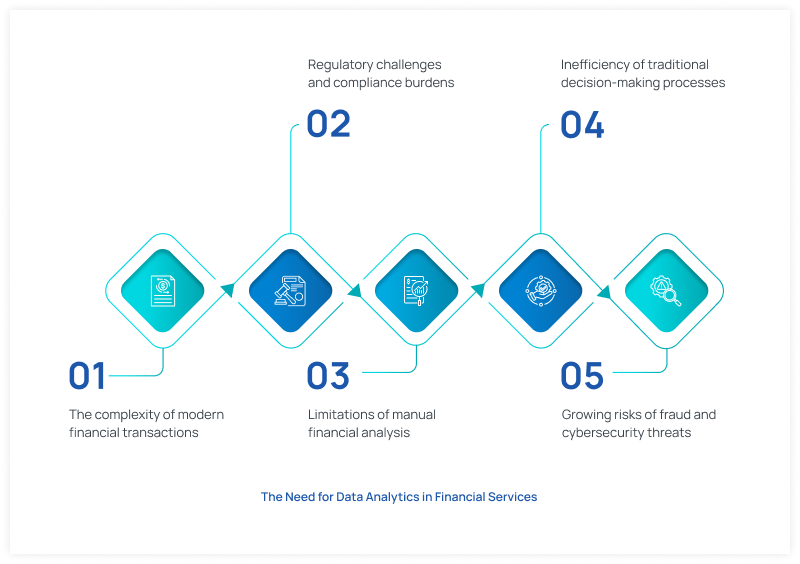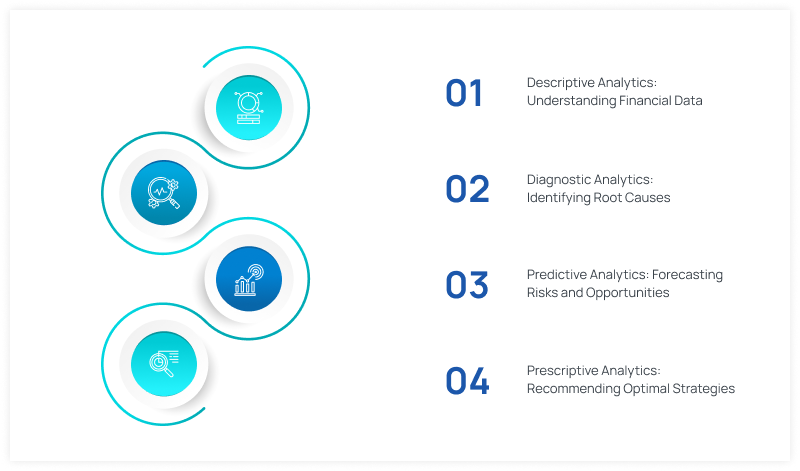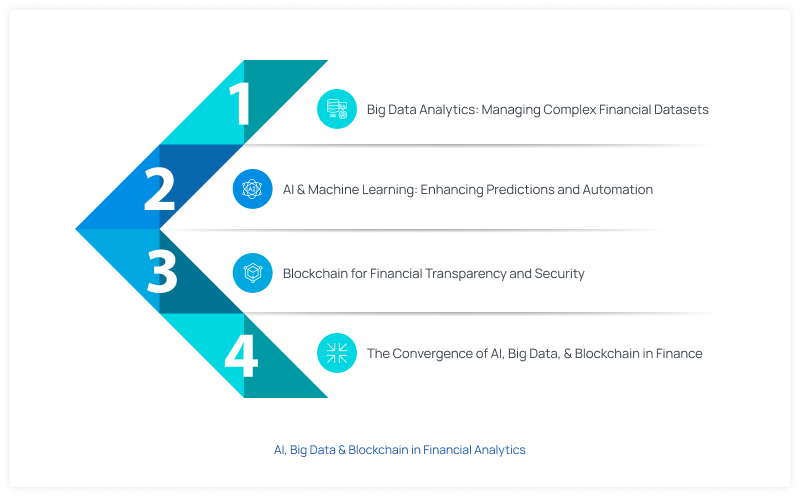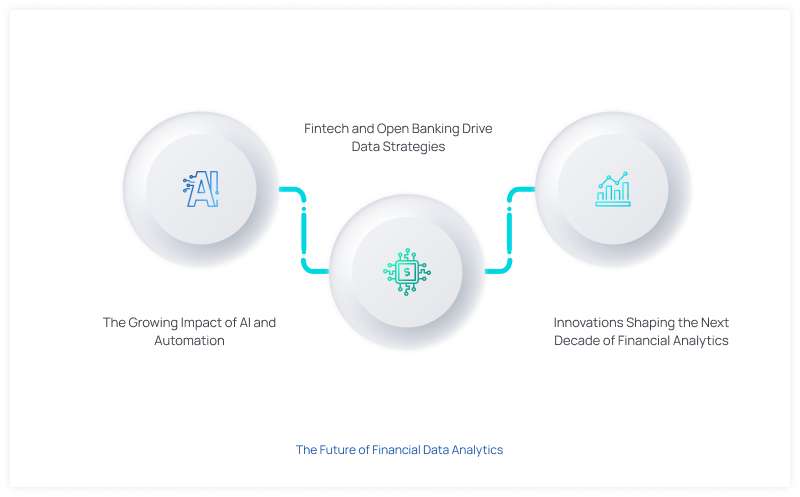Introduction
For decades, financial institutions have relied on manual processes, rule-based engines, and historical data to evaluate risks, detect fraud, and approve loans. Although these techniques offered stability, they lacked the agility and real-time intelligence required of today’s global economy’s engine.
To bridge this gap, data analytics in financial services employ AI and real-time insights to make informed decisions, improve operational efficiency, and provide hyper-personalized services that require keeping up with the pace of the rapidly changing wealth management landscape.
Whether it pertains to predictive modeling in investment banking, artificial intelligence-enhanced underwriting in lending, or real-time fraud detection in payment systems, data analytics capabilities enable institutions to maintain competitiveness, ensure compliance, enhance security, and prepare for future challenges.
The Need for Data Analytics in Financial Services

The complexity of modern financial transactions
Modern high-frequency transactions have evolved beyond simple exchanges. They now include cross-border payments, decentralized finance (DeFi) structures, and complex regulatory frameworks. This evolution makes it challenging for service providers in the cash-intensive industry to ensure security without advanced data analytics.
Data analytics in financial services simplifies these processes by providing predictive insights, automating reconciliation, and identifying patterns within the cash-intensive industry. It ensures accuracy in managing high-volume transactions and a dynamic, capital-rich ecosystem.
Limitations of manual financial analysis
In this high-frequency transaction industry, manual analysis is constrained by deterministic models and siloed data architecture, lacking in scalability and operational agility. These outdated methodologies fail to address market volatility, regulatory fragmentation, and fraud sophistication.
Advanced data analytics in the high-stakes investment sector automate real-time reporting using AI-driven insights, making predictions and speeding up the process of making strategic decisions.
Growing risks of fraud and cybersecurity threats
As financial services continue to evolve, so do the complexities of fraud and cybersecurity threats. Legacy security frameworks in the asset-heavy sector struggle to adapt to changing threats such as deepfakes, phishing, and ransomware.
Data analytics powered by AI and machine learning is crucial in this capital-rich landscape. It enables high-transactional entities to proactively detect anomalies, flag suspicious transactions in real time and enhance security posture.
Regulatory challenges and compliance burdens
Stringent monetary compliance standards hold a magnifying glass to every transaction, requiring meticulous reporting and transparency. Advanced intelligence systems, data analytics, and regulatory technology (RegTech) all work together to make compliance easier by
- automating regulatory reporting
- keeping track of policy adherence
- lowering the risk of fines
This process allows asset management companies to meet evolving compliance standards efficiently while maintaining operational agility.
Inefficiency of traditional decision-making processes
Relying on heuristic methods and manual assessments of a company’s financial health is no longer practical for decision-making. Financial analysts and companies are now using advanced data analytics and AI-driven tools.
With real-time Monte Carlo simulations, stress testing, risk modeling, and scenario analysis, they can quickly gain insights, turning tactical decisions into concrete actions that drive business growth.
Core Functions of Data Analytics in Finance
Fraud Detection and Risk Management
A 2024 report shows that global fraud losses surpassed $1.03 trillion in 2023, highlighting the urgency of sophisticated risk management frameworks. Data analytics in finance can help enterprises detect fraud with 99.99% accuracy.
By implementing predictive modeling, advanced anomaly detection, and AI-powered risk algorithms, financial institutions can proactively mitigate threats, reduce false positives, enhance operational efficiency, and maintain regulatory compliance in an integrated, complex, capital-rich ecosystem.
Customer Insights and Personalization
Wealth management entities struggle with delivering tailored solutions, resulting in lower customer engagement, increased attrition, and missed revenue opportunities.
With data analytics in financial services, dynamic behavioral clustering enables deeper customer insights, allowing granular personalization for target financial products and increasing customer lifetime value.
Also, churn risk-scoring models backed by neural networks enhance predictive accuracy, identifying high-risk clients and allowing banks, fintechs, and other institutions to execute precision-driven retention strategies.
Credit Risk Assessment and Loan Underwriting
Data analytics in financial services is like a high-precision radar system, constantly scanning and analyzing large financial datasets. It enables automated risk profiling for loan approvals, predicts loan defaults using ML algorithms, and integrates real-time credit scoring with alternative data sources.
These integrations of advanced technologies have coped with data analytics, making strides in monetary service providers to make faster, more informed decisions and reduce risk factors.
Regulatory Compliance and Anti-Money Laundering (AML)
Regulatory compliance on payment networks differs from country to country, adding layers of complexity. AI-powered data analytics fosters transaction surveillance, automating suspicious activity reporting (SAR) and compliance checks.
By ensuring data traceability and transparency, data analytics in financial services optimizes audit readiness and mitigates regulatory risks, driving operational efficiency.
Operational Efficiency and Process Automation
By leveraging advanced data analytics, machine learning algorithms, and RPA (Robotic Process Automation), manual financial processes are automated, reducing repetitive human errors.
The implementation of predictive analytics and real-time data aggregation leads to more timely financial reporting, resulting in improved overall operational resilience. This helps the capital-rich ecosystem be capable of responding to market fluctuations through advanced data analytics in financial services.
Types of Data Analytics Used in Financial Services

Descriptive Analytics: Understanding Financial Data
Extracting actionable insights from massive datasets can be quite difficult for risk management specialists. Descriptive analytics is a subset of data analytics that leverages past transaction data to identify spending trends and customer behavior. This drives financial institutions to offer bespoke solutions and enhance portfolio diversification. This type of analytics also helps identify various relationships between customers and products.
Example: A wealth management firm analyzes transaction data to categorize clients by risk tolerance, providing customized investment strategies that align with their financial objectives.
Diagnostic Analytics: Identifying Root Causes
Diagnostic analytics is one of the core types of data analytics in financial services. It dives deep into historical financial data and past events and identifies the root causes of financial anomalies. Through data correlation techniques, financial institutions can detect patterns, optimize internal processes, and refine decision-making that explains revenue shifts and operational inconsistencies.
Example: A fintech company analyzes historical fiscal data to find asset value declines, enabling swift corrective actions and enhancing client retention through targeted strategies.
Predictive Analytics: Forecasting Risks and Opportunities
Predictive analytics is the heart of the data analytics strategy, fostering transactional entities to forecast future events such as market trends, investment returns, and loan default probabilities. By employing data mining and predictive modeling, businesses can swiftly adjust strategies to future uncertainties and opportunities.
By leveraging advanced analytics, financial service providers can better anticipate potential risks and opportunities, enabling data-driven decisions.
Example: The Federal Reserve (USA) uses predictive analytics to forecast interest rate changes, assess inflation risks, and manage monetary policy. By analyzing market data, it anticipates future economic conditions, ensuring stability and growth in the high capital flow ecosystem.
Prescriptive Analytics: Recommending Optimal Strategies
HBS Online emphasizes that prescriptive analytics provides actionable insights and helps organizations make data-driven decisions to achieve their goals. Prescriptive analytics uses AI-driven portfolios and automated financial advisory services to come up with precise strategies.
This type of analytics performs this by using mathematical modeling and business rules. Prescriptive analytics guides essential areas, such as strategic planning, resource allocation, and pricing strategies, for optimal financial outcomes.
Example: A hedge fund manager leverages advanced quantitative models and real-time market analysis to devise optimized trading strategies, capitalizing on short-term market movements to drive return.
How Financial Institutions Leverage Data Analytics for Growth
Enhancing Investment Strategies and Wealth Management
Traditional portfolio management methods fail to adapt quickly enough to market changes, often exposing firms to greater risks. With the power of data analytics, firms can utilize AI-powered portfolio optimization and implement risk-adjusted asset allocation strategies.
Data-driven insights backed by advanced statistical models and algorithmic trading ensure that capital management firms remain agile and adapt to evolving market conditions.
Strengthening Fraud Prevention and Cybersecurity
Manual monitoring and outdated fraud detection systems struggle to keep up with sophisticated cyberattacks, leading transactional entities to increased risk and financial loss.
AI-driven data analytics enhances real-time fraud detection in financial transactions by analyzing behavioral patterns and identifying anomalies. Biometric authentication and identity verification integrate seamlessly, offering multi-layered security to ensure that only legitimate users can access sensitive financial data.
Optimizing Customer Experience and Digital Banking
Fragmented customer experience, delayed response, and lack of personalization often affect the customer’s banking experience. By leveraging artificial intelligence (AI) in data analytics, fiscal advisory firms can offer personalized recommendations tailored to individual preferences, enhancing customer experience.
To boost digital banking operations, integrating chatbots with predictive analytics can help understand customer needs, help with real-time assistance, optimize customer experience, and result in loyalty in digital banking.
Improving Loan Decision-Making and Credit Scoring
Ensuring Compliance with Financial Regulations
Compliance is often seen as a burden or cost center rather than a strategic advantage. Progressive capital market players are shifting their perspective on compliance from a risk management necessity into a strategic asset.
By integrating RegTech solutions, AI-enabled compliance automation, and advanced data analytics strategies, transactional networks can foster regulatory frameworks and improve client trust. Advanced algorithms enhance Anti-Money Laundering (AML) and Know Your Customer (KYC) processes, ensuring operational resilience and sustained compliance with evolving payment regulations.Increasing Efficiency in Back-Office Operations
Data analytics in the back office enhances operational efficiency by automating financial reporting and reconciliation. Through seamless data integration and predictive analytics, financial product companies reduce manual errors and streamline processes.
Robotic Process Automation (RPA) lowers costs even more by automating repetitive tasks like data entry and payroll processing. This makes better use of resources, boosts overall business performance, and ensures operational resilience.
AI, Big Data & Blockchain in Financial Analytics

Big Data Analytics: Managing Complex Financial Datasets
Financial service companies often face challenges in processing and analyzing vast, complex datasets, impacting workflow delays and data inaccuracies. Big data analytics solves these issues by using advanced analytics methods like machine learning, predictive analytics, data mining, and natural language processing to find patterns, relationships, and insights that are hard to find with traditional methods.
Especially in banking, big data analytics helps process high-value transactional data and aggregate information in real time. This enables banks to automate routine processes and minimize manual intervention, resulting in boosting productivity and smart decisions.
AI & Machine Learning: Enhancing Predictions and Automation
There is no doubt that artificial intelligence (AI) and machine learning (ML) are rewriting the DNA of data analytics in financial services. AI and ML models in data analytics play an important role, especially in fraud detection.
These models analyze large amounts of data from various sources in real time to identify deviations from standard behavior. AI-powered early warning systems utilize both supervised learning and unsupervised anomaly detection to accurately identify fraud early.
In parallel, capital flow businesses can optimize customer lifetime value (CLV) by integrating chatbots that access rich datasets and guide users through investment decisions and loan applications. With the power of data analytics, these advanced technologies foster customer-centric innovation, helping businesses stay one step ahead in the global economy.
Blockchain for Financial Transparency and Security
The duo of blockchain and data analytics in financial services aimed to place data at their core. This implies that transactional entities can reap a variety of benefits, primarily through the assurance of data authenticity and integrity.
Through data analytics, blockchain streamlines the high capital flow industry by offering secure transactions through decentralized ledgers, resulting in reduced fraud risks. Blockchain enables smart contracts to enhance cross-border payments based on pre-agreed conditions, ensuring security and efficiency.
With the help of real-time data analytics strategies, blockchain further detects anomalies, preventing transaction fraud and fostering highly secure transactions across borders.
The Convergence of AI, Big Data, & Blockchain in Finance
Much like a skilled orchestra, AI, big data, and blockchain are playing their part in creating a symphony of innovation in the capital flow ecosystem. This powerful synergy is defining the future of financial data analytics and reshaping how institutions operate, engage with customers, and manage risks. Here is how these convergences foster managing risks in wealth management entities:
- Blockchain’s decentralized feature offers immutable ledgers to ensure secure, transparent transactions, building trust through smart contracts in financial settlements.
- AI-powered predictive compliance frameworks use data analytics to find and reduce financial risks before they happen. This makes sure that regulations are followed and reduces the chance of leading to penalties.
- Big data refers to structured, unstructured, and complex data sets generated every day that help this cash-intensive industry with impactful solutions for long-standing issues such as improving risk management, making investment decisions, and driving customer trust.
Emerging Trends in Financial Data Analytics
Real-Time Analytics and Edge Computing
Financial markets move fast, and decisions must be made instantly. Real-time analytics equip banks, traders, and investors to monitor transactions, detect fraud, and respond swiftly to market shifts. With the help of AI-embedded tools, monetary advisory groups can analyze live market trends and fluctuations to take immediate action on risks and opportunities.
Traditional servers can’t be an option to maximize real-time financial data processing. Edge computing with data analytics enhances speed, resulting in improved decision-making speed. It helps banks, payment networks, and trading platforms handle high-speed transactions with minimal lag. With edge computing, wealth management entities can optimize data use, reducing unnecessary storage and improving operational efficiency.
AI-Powered Decision Intelligence in Banking
Banks are enhancing customer relationships and reducing costs by leveraging artificial intelligence to drive customer engagement. By integrating real-time data analytics, they streamline reporting processes and enhance decision-making accuracy.
AI-powered decision intelligence helps banks to stay agile and adaptive with the help of real-time data analytics. It eliminates wasting more time compiling reports and improves the decision’s accuracy. This intelligence system drives the complexities of banking operations further, easily leading to increased performance and better customer outcomes.
Augmented Analytics for Financial Reporting
Augmented analytics is a way of using data analytics in financial services to change the way financial reports are made by combining machine learning and natural language processing to automatically gather, analyze, and make sense of data.
Unlike traditional analytics, which often require technical expertise and time-consuming processes, augmented analytics leverages AI to automate financial report generation. By automating balance sheets and profit and loss (P&L) analysis, augmented analytics identifies patterns, anomalies, and risk indicators, enabling leaders to make data-driven decisions with precision.
The Rise of Regulatory Technology (RegTech)
Regulatory Technology (RegTech) is an innovative subset of Fintech that leverages technology to address compliance and regulatory issues in the liquidity-driven sector.
This solution leverages data analytics, AI, and machine learning to automate data collection, validation, and analysis, driving businesses to gain actionable insights into compliance risks and opportunities.
RegTech applications not only help in the fight against fraud but also utilize detailed data analytics to help this liquidity-driven sector identify inefficiencies and optimize workflows, resulting in greater operational efficiency and compliance effectiveness.
Challenges in Financial Data Analytics Adoption
Ensuring Data Privacy and Cybersecurity
Data analytics in the fiscal policy-influencing sector relies on large datasets, but ensuring data privacy is a major challenge. Improper access controls and weak classification systems can expose sensitive financial data.
Without robust encryption, compliance, and automated security, analytics-driven insights result in risk breaches, regulatory fines, and loss of client trust. Maintaining privacy without compromising analytics effectiveness remains a significant hurdle for many high-transaction frequency industries.
Overcoming Integration Issues with Legacy Systems
Old banking systems are often incompatible with AI-driven solutions due to differences in architecture and data formats. Modernization strategies, such as middleware or phased upgrades, to bridge the gap between old and new systems.
Adapting to new cloud infrastructures for improved scalability and analytics capabilities involving data security concerns and regulatory compliance. It ensures that banking systems have data integrity, security, and minimal downtime during the migration process while adapting to new cloud infrastructures for improved scalability and analytics capabilities.
Addressing Ethical Concerns in AI-Driven Finance
Biases in data collection, processing, and model building cause the primary concern with data analytics in AI-driven finance. If the data analytics process uses biased or incomplete data sets, there is a possibility that AI models may leverage and train on biased data.
These practices may lead to discriminatory outcomes, poor decision-making, and customer distrust, as well as undermine trust in AI-driven systems and affect the overall fairness of monetary solutions.
Navigating Evolving Financial Regulations
Adapting to evolving financial regulations is a major hazard in the adoption of data analytics. The cash-intensive industry must constantly update its systems to comply with new regulations such as data privacy and anti-money laundering laws while ensuring accurate, automated reporting and maintaining operational efficiency in a dynamic regulatory environment.
Financial institutions’ old data management and processing systems often can’t keep up with these region-specific compliance rules. This means that analytics frameworks and reporting protocols need to be updated often to keep up with the changing regulatory landscape.
The Future of Financial Data Analytics

The Growing Impact of AI and Automation
Self-learning AI models are called the future of AI in this high-cash-flow industry because they can be implemented much more quickly than supervised learning. Especially, data analytics in financial services can be optimized through machine learning algorithms to analyze datasets and identify patterns and trends that inform financial forecasting.
Capital management firms use risk assessment tools powered by AI to find outliers. This process speeds up the risk management process, cuts down on manual work, and improves operational efficiency.
Fintech and Open Banking Drive Data Strategies
The rise of fintech and open banking is transforming the landscape of data analytics by driving innovation and enhancing customer experiences. Open Banking is a framework that allows the high-capital flow industry to securely share customer data with consent from third parties.
This is facilitated through Account Information Services (AIS), which enable access to financial data for analysis, recommendations, and planning, and Payment Initiation Services (PIS), which allow third parties to initiate payments on behalf of customers.
As payment systems are innovating day by day, the integration of APIs is enabling institutions of liquidity-driven sectors to create interconnected data ecosystems. These AI-powered systems with ML algorithms and advanced data analytics allow banks to analyze customer behavior, predict financial needs, and offer personalized products. By embracing APIs and AI, the future of a transaction-heavy market will be shaped by smarter, more responsive, and customer-centric services.
Innovations Shaping the Next Decade of Financial Analytics
AI-powered robo-advisors are a digital automated portfolio management platform utilized by advisors in this cash-intensive industry to optimize investment strategies. It leverages ML algorithms to analyze financial data, avoiding human errors and enhancing decision-making precision.
With the help of blockchain and AI, a cash flow- driven market can ensure data integrity and fraud detection in real time. To further streamline risk assessment and resource allocation, advanced analytics and predictive modeling are leveraged for proactive risk mitigation and enhanced regulatory compliance.
Conclusion
Data analytics in financial services is no longer just a helpful tool but an imperative strategy. By leveraging advanced predictive modeling and ML algorithms, wealth management corporations are not only rewriting operational capabilities but also achieving unprecedented levels of business scalability and risk mitigation.
As the industry moves toward a data-centric architecture using AI-driven analytics frameworks and cloud-native solutions. It becomes clear that the ability to get useful insights from huge amounts of different types of data will be key to staying competitive in the future.
The integration of these technologies will redefine high-stakes investment sector capital allocation and strategic forecasting, ensuring that financial service companies stay ahead of volatility and regulatory complexes.
Discover how data-driven strategies can streamline your business growth and risk mitigation.
Let’s talk!
Unlock the Power of Generative AI in Financial Services
Discover how Generative AI can drive growth, enhance efficiency, and empower you to make smarter decisions with advanced data insights.
"*" indicates required fields